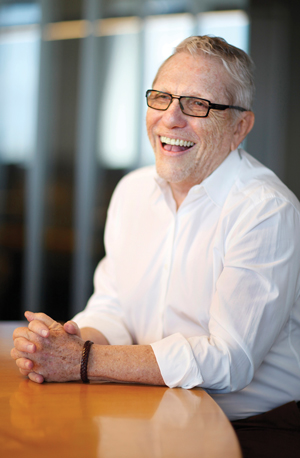Trending
The Closing: Bernard Zyscovich

Bernard Zyscovich has an unusual distinction beyond being the architect behind some of Miami’s biggest projects, including Miami’s Downtown Master Plan and the interiors of the Panorama Tower: He got into architecture school without knowing how to draw.
“The admissions officer told me, ‘This could be the worst portfolio I’ve ever seen,’” Zyscovich said of his interview at the Pratt Institute in New York City. “I had never done any drawing in [Hebrew] school…I realized I had no skills compared to everyone else. But I was an optimist.”
Won over by Zyscovich’s essay and good grades, Pratt eventually accepted him. After graduating and working for another South Florida architect for a handful of years, he founded Zyscovich Architects in 1977, operating out of a shed in his Miami backyard. Today, it’s an award-winning national firm with six partners, including Zyscovich, who is the managing principal, and about 120 employees located at its headquarters in Miami and across regional offices in West Palm Beach, Orlando, New York City and Bogotá, Colombia.
The company is currently working on some 50 projects around the U.S., including Florida East Coast Realty’s Panorama Tower, the enormous mixed-use project in Brickell that at 85 stories is the tallest residential tower south of Manhattan. The firm is also working with developer Moishe Mana in Wynwood. In New York City, Zyscovich designed Dumbo Heights, a five-building, 1.2 million-square-foot mixed-use campus in Brooklyn.
The 70-year-old, who grew up in Miami Beach, sat down with The Real Deal to talk about his childhood, his passion projects and the popular building concept of “real urbanism,” which he invented. The conversation has been condensed for space and clarity.
Age: 70
Hometown: Philadelphia
Lives in: Coconut Grove
Tell us a little about your childhood. My parents left Poland and Lithuania before the Holocaust. My father went first to Buenos Aires and then to Havana, where he met my mother, a Hebrew teacher. They moved to Philadelphia — I was born there — and then to Miami Beach, where we had relatives. My father died when I was eight years old, and my mother continued to work here as a Hebrew teacher.
I had learned how to play the accordion, and, when I was about 14, I played with a band and earned about $25 a night. At 15, I went to Israel and stayed for three months with relatives. I wanted to get away and meet girls.
Did you work for an architectural practice before setting up your own? After graduating from Pratt, I worked for five years with Lester Pancoast [a prominent Miami landscape architect]. He was my mentor.
You created the concept of “real urbanism,” which you develop in your book “Getting Real About Urbanism.” What does it mean? Real urbanism means building a plan around all that is unique and authentic about a place, creating places that have identifiable character and personality, as opposed to imposing a predetermined design solution.
What are the most difficult projects you’ve worked on? The airport in Bogotá (El Dorado) was on a very large scale, and we had to work while this international airport was still operating, with plans and instructions in Spanish and English. [Zyscovich has been speaking Spanish since he was a child.] We had to complete the project in a year. The result was fabulous — the airport is filled with large spaces and walls of glass. They don’t need to turn on the lights until the evening.
In most situations, “difficult” means that the client’s vision of the project changes over time, and you lose the [original] sense of purpose.
What are some of the most rewarding projects you and your firm are undertaking? Our commitment to civic and community-based projects is ongoing in essentially all our public-sector work. We have created schools that are cutting edge in education, community facilities and other important works. Some examples of our 21st Century schools program are the Galaxy E3 Elementary School in Boynton Beach, the performing arts center for the Miami Country Day School and the new plan for Palmetto Senior High in Pinecrest.
What is the impact of new technology on architecture today? Technology is allowing us to design in a three-dimensional world. It is a very special moment in the creative fields because the tools or visualization are becoming quite powerful and exciting.
When combining visualization with the opportunities for computer-generated fabrication techniques, we are on the cusp of a whole new way of implementing building projects.
How has architecture changed since you began working in the profession? The role of the architect has changed significantly since the days of hand drawing. In the case of very large institutional projects, there are now new services that have been inserted in the process by other service companies whose sole role is to serve as the owner-architect go-between. These companies manage the design and construction process instead of the owner taking that role directly. This has changed the relationship between the architect and his client to one where the architect is performing services at arm’s length. The opportunities for positive impact that comes from the architect-client dialogue have unfortunately been diminished.
Do you have any advice for young architects? Always look for the purpose behind what you are doing and stay true to your beliefs. Work hard and keep in mind why you were attracted to this profession in the first place. Everything you do should add value to our society.




